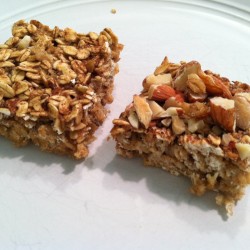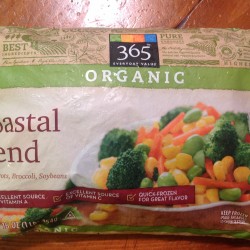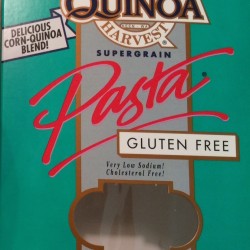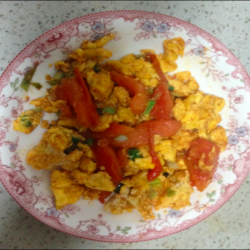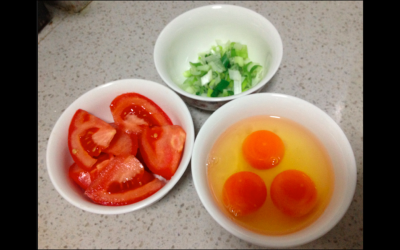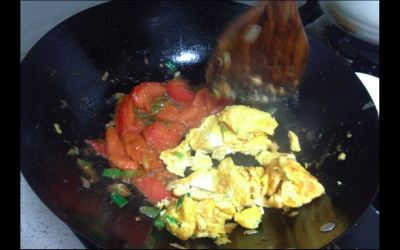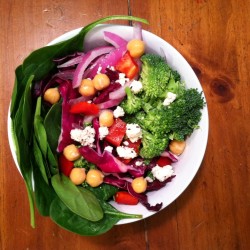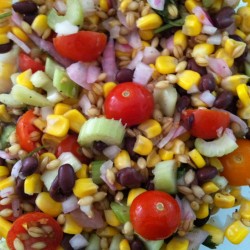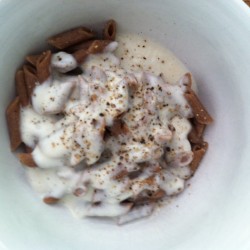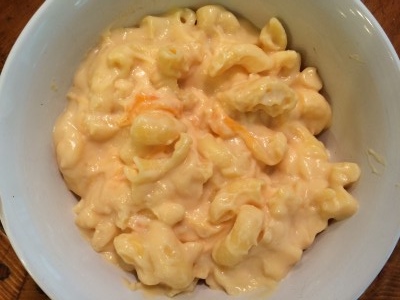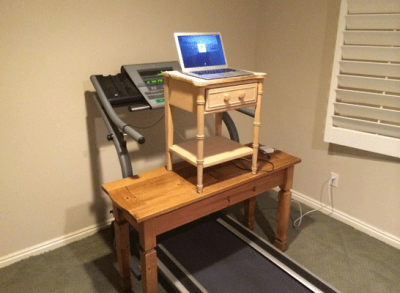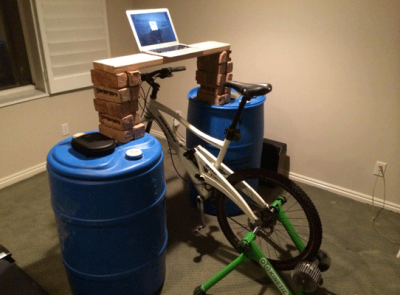Podcast: Play in new window | Download
Subscribe:
Real Food First: A Simple Guide to Losing Weight, Getting Kids to Eat Healthy, and Feeling More Energy
When we returned home from our first visit to China’s Longevity Village, we asked ourselves, “With all the junk food our kids encounter at school, church, playdates, scouts, sports, and practically everywhere in our society, how can we help our kids not only eat healthy, but develop a desire to eat healthy?”
The pay off of good habits developed early was apparent in the village. We were so impressed how a group of people in this village were able to feel so good, have so much energy, and escape the chronic medical conditions that we see everywhere in the U.S. None of them were taking any medications and they were still growing their own naturally organic food well into their 80s, 90s, and 100s.
The traditional diet of China’s Longevity Village is a diet consisting of vegetables, fruit, beans, nuts, seeds, and fish. They eat vegetables with every meal, including breakfast. There was no added sugar, limited grains except for unrefined brown rice, and limited animal meat. Dairy was not part of their diet as they are lactose deficient.
The Junk Food Life
It is so difficult to eat healthy as a kid in our society. School lunches are horrible. Little league coaches, scout leaders, and church leaders often enjoy offering “treats” to our kids. But how rewarding are these “treats” when kids in the U.S. are becoming overweight at an alarming rate and developing chronic conditions earlier and earlier in life?
Eating junk food has become the norm. How do we help our kids break away from the path of least resistance and take initiative to make healthier behaviors? We can’t always be with them. Somehow, we have to help them develop the desire and the tools to make their own healthy choices.
Like most parents, we are trying to empower our kids with knowledge about what their bodies need and why. We teach them to read labels. We teach them how food grows. We try to help them practice balance–maximizing the good and minimizing the bad. All these things are good, but left to their own devices, our kids still tend to prefer the not-so-healthy choices and go for the less healthy ones.
Recently, we’ve been trying a new approach: Eat Real Food First.
Let me explain. With each meal we offer and encourage our children to eat vegetables, a fruit, a healthy fat, and a healthy protein. If their bodies tell them that they are still hungry after their fruit, vegetables, healthy fat, and healthy protein, then they can choose to eat additional foods, including not-so-healthy items, if desired. We are finding that by filling up on real food first, our desire for and the amount of junk food we actually eat decreases.
Tips for Getting Kids to Enjoy Vegetables
Getting kids to eat vegetables can be challenging. Vegetables are something that we know few others will offer to our kids so we make sure to at least offer some form of a vegetable to our kids with each meal.
When given the choice, our kids will always opt for the carrot sticks. While carrots are extremely healthy, we try to make sure that by the end of the day they have had a rainbow of vegetable colors (orange, green, red, etc.). Of the rainbow of colors, we try to make at least one of them a cruciferous vegetable (broccoli, kale, cauliflower, etc.)
Most often, they like the vegetables raw with a salad dressing for dipping. However, more and more, they are enjoying stir-fry dishes with different sauces. Our 9- and 11-year-old sons now declare that curry is their favorite, our 6-year old daughter likes hoisin sauce.
We invite the kids to cut and cook the vegetables with us. Somehow, working with the food itself helps them to enjoy eating it more. They each have developed their favorites to chop–one particularly likes to chop onions, another zucchini, and another carrots. Whatever works!
If there are certain vegetables they traditionally resist, we find that when we cut them up small and mix them with a variety of other colorful vegetables, we have more success. A vegetable they’ve always “hated,” often gets eaten without comment or fuss.
Our next step is to grow some of these foods ourselves.
We’d love to hear your suggestions, questions, and successes helping your family to enjoy vegetables. Please share your comments at the end of this blog.
What fruits do we encourage?
Fruits are not so difficult. We can’t think of a fruit our kids won’t eat. We always try to have a wide variety of fruits peeled and cut up ready to eat with each meal. It could be something as simple as a few organic strawberries, half of an orange, or a small bunch of organic red grapes. One small serving of a fruit with each meal is enough and can address the desire for something sweet.
“Hunger Carbs” vs. “Filling Carbs”
Vegetables, legumes (beans and lentils), and to a lesser extent fruit, are what we call the “filling” or “healthy” carbs. These carbs, which are slowly digested, do not result in big sugar or insulin spikes, and heal us. These carbs fill our bellies and allow us to feel full.
These “filling” or “healthy” carbs stand in stark contrast to the “hunger” or “disease” carbs. The hunger carbs result in rapid sugar and insulin spikes. They cause us to become hungrier and cause our bodies to break down and become sick.
Have you ever wondered why you can have bowl after bowl of Fruit Loops and never feel full? The hunger carbs are bread, including whole wheat bread, pasta, sports drinks, soda pop, pastries, crackers, and most processed foods.
If you eat the “hunger carbs” you will just be hungry again in a very short period of time. The “hunger carbs” are one of the biggest reasons why we are gaining unneeded weight.
What healthy fats do we encourage?
For their healthy fats we encourage things like nuts or nut butter of any kind, seeds or seed butter of any kind, hummus, or even Wild Alaskan Salmon.
For the longest time, none of our kids would eat fish. But after offering it over and over and over, all three of them have now learned to enjoy Salmon. They even ask for it when we are planning meals! We like the Wild Alaskan Salmon because it offers the best fish health benefits with minimal mercury, dioxin, or PCBs.
If they are asking for “milk,” healthy fats choices could also include organic unsweetened almond milk, coconut milk, or soymilk. We realize that soy can be a controversial food item for some people. This is likely because of how we eat soy in the U.S. Our soy here is genetically modified (GMO) and processed, not using the whole bean. The organic soymilk we buy does use the whole organic soybean, not merely isolated components or added chemicals. We just make sure we read the labels carefully.
Countless medical studies from Asia have demonstrated the health benefits of soy. This is likely because they eat the whole bean and the beans they traditionally used were non-GMO. If you choose to drink soymilk only buy the organic unsweetened whole bean varieties.
If they are asking for a dessert or something sweet, assuming they have not already had candy offered to them from someone else, we may offer dark chocolate. Our kids have learned to love even 80% cacao dark chocolate. The darker the healthier. Dark chocolate includes many healthy fats. We have recently begun mixing nut butters with almond milk, cocoa and stevia. This concoction is a step up in nutritional value from traditional sweets and satisfies our sweet tooth. And, somehow, a smaller amount seems to satisfy, rather than producing an unquenchable desire to eat more and more, as the others sweets usually do.
What healthy proteins do we offer?
For a healthy protein with each meal, we offer our children the same foods listed above that provide the healthy fats–nuts or nut butter of any kind, seeds or a seed butter of any kind, legumes (lentils or beans of any kind), hummus, or Wild Alaskan Salmon.
As most of our suggested healthy fats and proteins are on the same list, depending on what our kids want to eat, one serving of something high in the healthy fats and proteins could suffice for both.
We understand that some of our recommended healthy proteins are not complete proteins with all of the necessary amino acids (i.e. lentils, beans, nuts, and seeds). This is not a concern to us as our kids will also get other protein sources during the day which will round out their amino acid profile. For example, at some point during the day, our kids will want a sandwich or a bowl of a healthier cereal.
Ideally, the sandwich or cereal comes after eating the real food first. Otherwise, it’s easy to fill up on the less-nutrient-rich foods and not want the more nutritious foods afterwards. The protein from the whole grains in these items will make a complete protein when combined with lentils, beans, nuts, or seeds.
We try to offer the healthiest possible versions of the snack foods they ask for at home—i.e. chips, crackers, treats, and we encourage them to be eaten with meals, No foods are forbidden or restricted, as we’ve seen that this can create unintended problems in itself. We know that they will certainly find the junk food at school, a friend’s house, or at church, etc. Our intent is to be relaxed about these realities in our society.
The important thing is that we have at least given them three opportunities each day to provide them with real food first to help keep them healthy.
Day by day, our kids are relaxing into the idea of eating real food first with every meal we have together. Sometimes they even take their own initiative to get the healthy stuff first. Sometimes. We hope this is a work in progress, and will continue to build over time. We’re not there yet, but we are finding that this approach is helping us to guide our children to eat healthy.
Real Food First is the adaptation of China’s Longevity Village Diet to an American lifestyle, which helps us to more successfully navigate the realities of our society and live better.
How to Start Eating Healthy as the Best Way to Lose Weight
As a cardiologist, 80% of the health problems that I see every day could have been avoided with healthy lifestyle choices. The benefits of eating healthy, reducing stress and moving more are truly life changing.
The question among my patients is always: “how do I start eating healthy and what is the best way to lose weight?” Carrying extra weight is one of the biggest factors causing so many of the health issues I see today.
Unfortunately, less than 5% of diets work long-term. Eating less does not work because your body’s metabolism just slows down and you are hungry all of the time. This just makes you tired and irritable.
Exercising alone to lose weight doesn’t work either. Vigorous exercise can just work up an appetite and, if left unchecked, will cause you to negate any calories you may have burned off with one sports drink, a treat, or a big meal.
By eating real food first, we can give our body all the nutrition it needs for optimal health and eat the foods that will fill us. Eating real food speeds up your metabolism, so that you burn more calories through the day. Filling up with real food first, in combination with exercise and moving throughout the day, really is the best way to lose weight.
Step 1: Real Food First
Step 1 of the Real Food First Diet is really quite simple. At each meal, before you eat anything else, have a fruit, two vegetables, a healthy fat, and a healthy protein. The list of suggested items above for our kids is exactly what you could use as you are starting as well.
You have to be religious about starting every meal, including breakfast, with real food first. Vegetables are not typically part of a traditional American breakfast. Let’s change that.
For breakfast, steam up some broccoli as a side with your oatmeal sprinkled with your favorite nuts and almond milk. Make a delicious salad. If you love your eggs, mix in tomatoes, onions, garlic, broccoli, zucchini—whatever you have. For eggs, I recommend organic, pasture raised, local eggs. Never go a meal, especially breakfast, without eating Real Food First.
Step 2: Nothing is Forbidden After Eating Real Food First
After you have finished eating Real Food First, if your body tells you that you are still hungry, decide what you need. Remember it takes at least 20-30 minutes before your brain gets the message you are full so eat slowly and wait a while after eating real food first. No foods are forbidden or restricted with the Real Food First Diet. There is no counting the calories.
Of course, this is not license to binge or disregard the signals your body is sending you! Listen to your body. If you decipher that you are physically full, but still “hungry” for something else, stop eating, figure out what you really need, move on to another activity, and reassure yourself that you can eat again when you are hungry.
Ideally, you will fill up on the real food first so that you body’s natural weight regulation system will kick in and regulate your weight to the ideal weight. The problem comes when we eat the “hunger carbs.” These are the carbs that our body immediately turns into sugar like bread (even whole wheat), pizza, pasta, crackers, processed foods, desserts, etc.
The more “hunger carbs” we eat, the hungrier we will be. This results in high insulin levels that completely override all of our body’s natural weight regulation system.
If you love bread, like me, try switching to Ezekiel bread, which has no flour and is very high in protein and fiber. As this bread is not rapidly converted to sugar, like traditional whole wheat or multi grain breads, it is considered a “filling carb.” Even our kids like Ezekiel bread. It makes great French toast and sandwiches (especially when toasted). We also enjoy Ezekiel buns, cereals, and pastas.
Step 3: Real Food First with Snacks
If you are hungry between meals then the Real Food First Diet allows you to snack as long as you snack on real food first. We find that if you are eating real foods first, most people do not get hungry between meals. If you do, have a vegetable, healthy fat, or healthy protein first.
Like with mealtime, if your body tells you that you are still hungry after a vegetable, healthy fat, or healthy protein, then you can eat what you need. Once again, give your brain 20-30 minutes to get the message you are full. No foods are restricted or forbidden once you have had real food first.
Immediate Weight Loss
Depending on your previous diet and how overweight you are, you could lose anywhere from 5-20 pounds in your first 10 days by eating real food first. While this is primarily water weight from the simple carbs or “hunger carbs” (bread, pasta, sports drinks, sodas, pastries, crackers, processed foods, etc.), it is still exciting to see the weight drop so fast at first.
After this initial weight loss, most of my patients see a gradual one to two pound weight loss each week when they eat real food first in conjunction with regular daily exercise (30 minutes if moderate intensity/15 minutes if high intensity) and 10,000 steps daily.
With most diets, people quickly gain back all of the weight, and then some, with eating real food first this is not the case. This is a lifestyle change. There is no specific “diet” or meal plan. Just eat real food first and if your body tells you that you are still hungry after the real food then you can eat what you need. There is no hunger. There is no deprivation.
Reclaim Your Energy
In addition to the rapid weight loss in week number one, the biggest thing my patients notice is how much better they feel. Suddenly, it was as if some one gave them all of their energy back.
Rather than just sitting and feeling tired they suddenly wanted to get up and start doing something. Many of my patients have told me that they have not felt this good and energetic in years.
Yes, real foods give us energy. If we can get rid of the energy draining “hunger carbs” or the “disease carbs” and replace them with the “filling” or “healthy” carbs, we can have as much energy as we had when we were kids.
Make Real Food First a Habit!
We have found that with every new habit, tracking our progress is one of the most important things for success. To help you put Real Food First and reclaim your health and energy now, please sign up for Dr. Day’s free Healthy Habit Tracker App on the resource page of our website.
By signing up for this program, you will get a daily email reminding you to record your progress for the day. You can even earn “medals” for the number of days you consistently fill out the form. It is never too late to change!
How about you? How do you put real foods first? Have you found success in reaching and maintaining your ideal weight with real foods? Please help others by sharing your questions and experiences here. You can leave a comment by clicking here.


